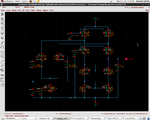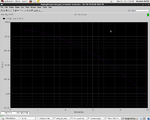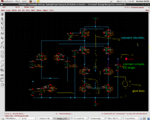jane_miemie
Newbie level 2
Hi everyone,
I'm new to op amp design. I've finished designing a single-ended folded cascode op amp but the open loop gain is fairly low. I'm not sure whether I set up the open loop gain configuration wrong or not. Another problem is now the output resistance is very high, can anybody give me an idea how to lower it? NEED HELP!!! Thanks a lot!!!
I'm using TSMC 0.2um and the specifications I use are listed below:
Vthn = 0.38V Kn = Un*Cox = 226.4uA/V^2
Vthp = -0.422V Kp = Up*Cox = 100.4uA/V^2
Vdd = 2.5V
CL = 10pF
slew rate = 10V/us
output voltage: min = 0.5V max = 2V
input CM voltage: min = 1V max = 2.5V
power dissipation < 5mW
Av > 60dB
GB = 10MHz


I'm new to op amp design. I've finished designing a single-ended folded cascode op amp but the open loop gain is fairly low. I'm not sure whether I set up the open loop gain configuration wrong or not. Another problem is now the output resistance is very high, can anybody give me an idea how to lower it? NEED HELP!!! Thanks a lot!!!
I'm using TSMC 0.2um and the specifications I use are listed below:
Vthn = 0.38V Kn = Un*Cox = 226.4uA/V^2
Vthp = -0.422V Kp = Up*Cox = 100.4uA/V^2
Vdd = 2.5V
CL = 10pF
slew rate = 10V/us
output voltage: min = 0.5V max = 2V
input CM voltage: min = 1V max = 2.5V
power dissipation < 5mW
Av > 60dB
GB = 10MHz


